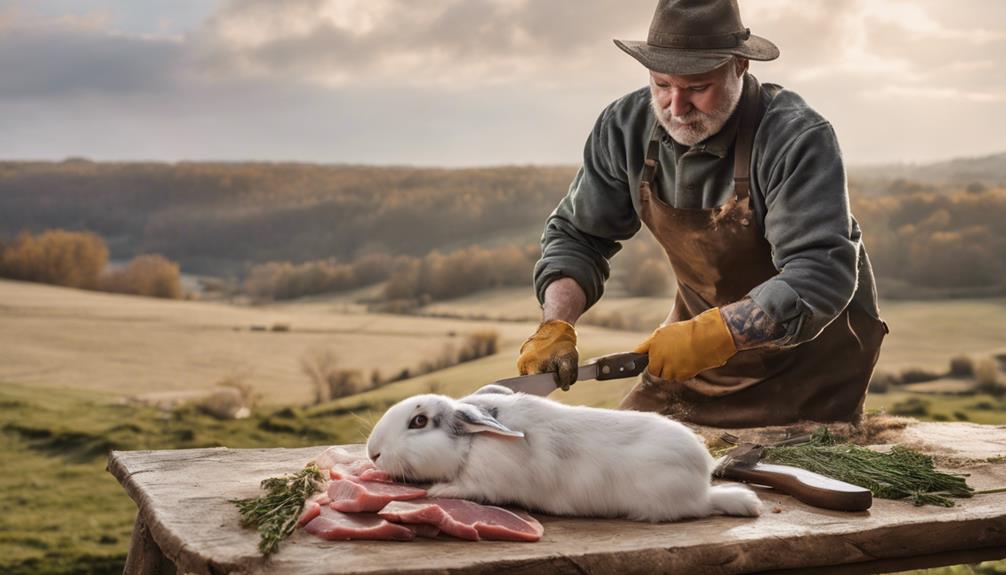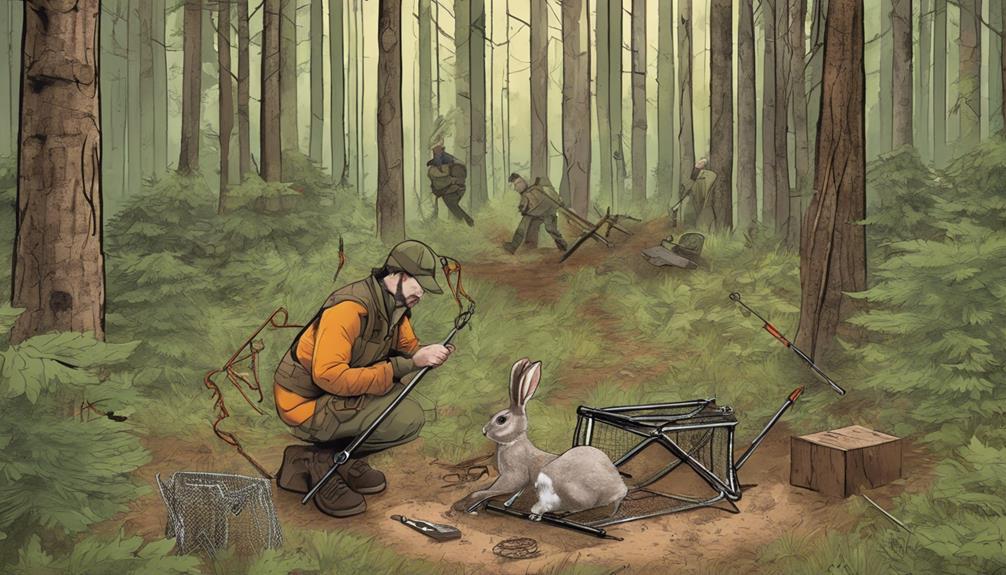10 Best Tips for Successful Rabbit Hunting and Preparation
To succeed in rabbit hunting, equip yourself with proper gear like camouflage attire and insulated boots. Identify rabbit habitats by exploring dense vegetation and watching for feeding signs. Approach silently, blending with surroundings and find a strategic spot. Understand rabbit behavior to predict their moves and improve your hunting technique. Sharpen shooting skills with varied targets and stances. Practice hygiene and cooking skills for rabbit preparation. Use decoys, calls, and traps for successful hunts. Prioritize safety with necessary tools and survival knowledge. Master these tips to maximize your hunting potential and culinary satisfaction.
Choosing the Right Hunting Gear
When gearing up for rabbit hunting, ensure you have the appropriate tools for the job to increase your chances of a successful hunt. Proper clothing is essential for comfort and safety. Opt for earth-toned, camouflage attire to blend in with the surroundings. Wear layers to regulate body temperature and choose waterproof gear if hunting in damp conditions. Insulated boots are crucial for traversing various terrains comfortably.
Equipment selection plays a vital role in your hunting success. Maintain your gear regularly to ensure it functions correctly when needed. Check your firearms for any signs of wear and clean them properly after each use. Practice proper gun safety at all times. Choose a shotgun for rabbit hunting due to its spread pattern, which increases the likelihood of hitting a fast-moving target like rabbits. Additionally, consider using a scoped .22 rifle for more precise shots if hunting in areas with longer sightlines.
Target practice is an essential aspect of preparing for rabbit hunting. Spend time honing your shooting skills to increase accuracy. Set up targets that mimic a rabbit's size and movements to simulate hunting conditions. Practice shooting from various distances and angles to prepare for different hunting scenarios. Familiarize yourself with your equipment to ensure you can handle it confidently in the field. By maintaining your gear, selecting appropriate equipment, and practicing your shooting skills, you'll be well-prepared for a successful rabbit hunting expedition.
Identifying Rabbit Habitats
To effectively identify rabbit habitats, observe the landscape for specific characteristics that cater to the needs of these elusive creatures. Habitat exploration and wildlife observation are key to locating areas where rabbits are likely to be found. Look for places with dense vegetation like shrubs, bushes, and tall grass that provide cover and protection. Rabbits prefer areas with a variety of vegetation types, offering both food and shelter.
Understanding their foraging habits is crucial. Rabbits are herbivores and feed on a variety of plants such as clover, grass, and vegetables. Look for signs of feeding activity like chewed vegetation and droppings. By observing these foraging patterns, you can pinpoint areas where rabbits are actively feeding.
Burrow identification is another important aspect of finding rabbit habitats. Rabbits dig burrows for shelter and protection. These burrows are typically located in areas with soft soil, often near dense vegetation. Look for small holes or openings near bushes or tall grass that could indicate the presence of rabbit burrows.
Mastering Stealth and Patience
Developing excellent stealth and patience is fundamental to successful rabbit hunting, requiring a combination of skill and strategy. When it comes to stealth techniques, movement should be slow and deliberate. Avoid sudden noises or quick motions that could startle the rabbits. Move quietly, placing your feet carefully to avoid snapping twigs or rustling leaves. It's crucial to blend into your surroundings; wear camouflage clothing that matches the environment you're hunting in. Additionally, consider using natural covers like bushes or trees to conceal your presence.
Patience is a virtue in rabbit hunting. Find a good vantage point near rabbit trails or feeding areas and wait silently. Rabbits have keen senses, so it's essential to remain still and quiet for extended periods. Avoid unnecessary movements that could alert the rabbits to your presence. It may take time for the rabbits to feel safe enough to come out of hiding, so be prepared to wait patiently.
To enhance your stealth and patience strategies, practice mindfulness and focus. Pay attention to the sounds and movements in the environment to anticipate the rabbits' behavior. By mastering these skills, you increase your chances of a successful rabbit hunting expedition. Remember, patience and stealth go hand in hand when it comes to outsmarting these elusive creatures.
Understanding Rabbit Behavior
Understanding Rabbit Behavior involves observing their habits and reactions in various situations to predict their movements accurately. Rabbits have a complex social structure and rely heavily on communication to interact with one another. They use a variety of vocalizations, body language, and scents to convey messages within their warren. By understanding these communication methods, you can gain insight into their current state and intentions, aiding in your hunting strategy.
In the wild, rabbits are constantly alert to potential threats due to their natural instincts for predator evasion. They've keen senses of hearing, smell, and vision, allowing them to detect danger from afar. When hunting rabbits, it's crucial to approach with caution and remain as quiet as possible to avoid triggering their flight response. Understanding how rabbits perceive the environment can help you anticipate their reactions and plan your movements accordingly.
Rabbits exhibit intricate behaviors when faced with danger, such as freezing in place, fleeing to safety, or seeking cover in their burrows. By familiarizing yourself with these behaviors through observation and research, you can better predict their responses during a hunting expedition. Remember to respect their natural instincts and adapt your hunting techniques to align with their behavioral patterns for a more successful outcome.
Practicing Accurate Shooting Techniques
When honing your rabbit hunting skills, mastering precise shooting techniques is paramount for a successful hunt. Improving accuracy requires consistent target practice. Start by setting up targets at varying distances to simulate real hunting scenarios. Proper stance is crucial; stand with your feet shoulder-width apart, perpendicular to the target, and ensure a firm grip on your weapon. Align your dominant eye with the sights of the gun, focusing on the front sight. As you aim, control your breathing, exhaling gently as you squeeze the trigger. Remember, a smooth trigger pull is key to avoiding jerking the gun and missing your mark.
To enhance your accuracy further, consider utilizing reactive targets that provide immediate feedback upon impact. This can help refine your aim and adjust for any errors in your technique. Additionally, practicing shooting from different positions such as kneeling or sitting can better prepare you for the unpredictability of hunting in the field. Regularly assess your progress by keeping a log of your sessions, noting any improvements or areas that need more work.
In essence, consistent and deliberate target practice is the cornerstone of honing your shooting skills for rabbit hunting. By focusing on improving accuracy through proper technique and regular training, you'll significantly increase your chances of a successful hunt.
Employing Effective Hunting Methods
To maximize your success in rabbit hunting, employ strategic methods that capitalize on the behavior and habitat of the prey. Start by adopting a silent approach as you move through the hunting grounds. Rabbits have keen hearing and can easily detect even the slightest noise, so tread softly and avoid unnecessary disturbances. This will prevent alerting the rabbits to your presence, giving you a better chance of getting closer for a successful shot.
Strategic positioning is another crucial aspect of effective rabbit hunting. Familiarize yourself with the rabbits' habits and preferred locations within their habitat. Look for areas with dense vegetation, such as brush piles, hedgerows, or edges of fields, where rabbits often seek shelter or forage for food. Position yourself downwind from these spots to avoid your scent being carried towards them, which could scare them off.
When choosing your hunting spot, consider setting up near natural barriers like fallen trees or large rocks that can provide cover and help conceal your presence. This strategic positioning won't only increase your chances of spotting rabbits but also offer you a clear line of sight for a successful shot. By combining a silent approach with strategic positioning, you can enhance your hunting efficiency and bring home a successful harvest.
Handling and Preparing Harvested Rabbits

When handling and preparing harvested rabbits, ensure that you follow proper sanitation and hygiene practices to maintain the quality and safety of the meat. After harvesting a rabbit, it's crucial to skin it correctly to preserve the meat. One common skinning technique involves making a small incision at the base of the rabbit's tail, then carefully peeling the skin off the body, working your way towards the legs and finally the head. This method helps retain the quality of the meat and is commonly practiced by hunters and butchers.
Once the rabbit is skinned, you can move on to preparing it for cooking. There are various delicious cooking recipes that you can try, such as rabbit stew, grilled rabbit, or even fried rabbit. One popular recipe involves marinating the rabbit meat in a mixture of herbs and spices before grilling it to perfection. Another favorite is slow-cooking rabbit meat with vegetables and broth to create a hearty stew.
Remember to handle the rabbit meat with care to avoid any contamination. Always wash your hands thoroughly before and after handling the meat, and ensure that your cooking utensils are clean. By following these skinning techniques and cooking recipes, you can enjoy a delicious meal that you harvested yourself.
Utilizing Rabbit Decoys and Calls
For effective rabbit hunting, employing rabbit decoys and calls can significantly enhance your chances of attracting these small game animals in the wild. When utilizing these techniques, it's important to consider the following:
- Using Scent: Rabbits have a keen sense of smell, so incorporating scents that mimic natural rabbit odors can help attract them to your hunting area. Utilize rabbit urine or gland scents to make your decoy more appealing.
- Visual Decoys: Visual decoys can be highly effective in catching the attention of curious rabbits. Opt for decoys that resemble rabbits in distress or feeding to pique the interest of passing rabbits.
- Calling Techniques: Mastering rabbit calls is crucial for success. Learn to mimic rabbit distress calls or mating calls to lure rabbits towards your hunting spot. Practice different cadences and tones for a more authentic sound.
- Lures and Baits: Alongside decoys and calls, using lures and baits can further entice rabbits to approach your hunting area. Consider incorporating fresh vegetation or specially formulated rabbit attractants to increase your chances of a successful hunt.
Learning Tracking and Trapping Skills

Enhancing your rabbit hunting skills involves developing proficiency in tracking and trapping techniques to effectively capture these elusive game animals in their natural habitat. To improve your tracking abilities, start by mastering camouflage techniques. Blend with the environment by wearing clothing that matches the colors and textures of the surroundings. Move quietly, staying low to the ground to avoid detection. Observing rabbit habitats, such as brush piles, thickets, or burrows, can give you clues about where to focus your tracking efforts.
When it comes to trapping methods, understanding the behavior of rabbits is key. They're known to follow specific paths repeatedly, so setting up traps along these routes can increase your chances of success. Use baiting strategies like carrots, lettuce, or apples to lure rabbits into your traps. Position the traps strategically, ensuring they're well camouflaged and securely placed to prevent escape.
For effective tracking, pay attention to subtle signs like footprints, droppings, and chewed vegetation. Rabbits leave distinct trails, and learning to identify these indicators can lead you straight to your target. Practice your tracking skills regularly to hone your abilities and become a more efficient hunter. Remember, patience and persistence are essential when mastering the art of tracking and trapping rabbits in the wild.
Staying Safe in the Wilderness
To ensure your safety while rabbit hunting in the wilderness, understanding potential risks and taking necessary precautions is vital. When venturing into the wild, being prepared can make all the difference in keeping yourself safe. Here are some key tips to help you stay safe:
- Emergency Protocols: Familiarize yourself with emergency protocols for the area you're hunting in. Know how to signal for help and have essential supplies like a first aid kit and emergency blanket readily available.
- Self Defense: While the likelihood of encountering dangerous animals is low, it's crucial to be prepared. Carry bear spray or a whistle for self-defense and to attract attention if needed.
- Navigation Skills: Ensure you have a reliable map, compass, or GPS device to aid in navigation. Familiarize yourself with the terrain before heading out, and always inform someone of your planned route.
- Survival Tactics: In the event of getting lost or stranded, knowing basic survival tactics can save your life. Learn how to build a shelter, find water sources, and signal for rescue.
Frequently Asked Questions
Can Rabbits Carry Diseases That Could Be Transmitted to Humans?
Yes, rabbits can carry diseases that pose zoonotic risks to humans. Rabbit diseases, such as tularemia and rabbit fever, can be transmitted to humans through contact with infected animals or their feces.
It's important to take precautions when handling rabbits to minimize the risk of disease transmission. Follow proper hygiene practices and wear protective gear to reduce the chances of contracting any illnesses from rabbits.
Are There Specific Regulations or Laws for Rabbit Hunting in Different Regions?
In different regions, regulations govern rabbit hunting to ensure conservation and safety. These rules may dictate hunting seasons, bag limits, and weapon restrictions. It's essential to abide by these regulations to protect rabbit populations and maintain a sustainable ecosystem.
Additionally, understanding any potential diseases carried by rabbits, like tularemia, is crucial to prevent transmission to humans. By following regulations and being aware of disease risks, you can enjoy a safe and responsible hunting experience.
How Do You Properly Store and Preserve Harvested Rabbits?
You can store and preserve harvested rabbits properly by utilizing various methods. Freezing techniques involve wrapping the rabbit in plastic wrap and then placing it in a freezer-safe bag.
For canning, ensure the meat is properly cooked and follow a canning recipe for safety. Both methods help extend the shelf life of the rabbit meat and maintain its quality for future consumption.
What Are Some Common Mistakes to Avoid When Rabbit Hunting?
When rabbit hunting, common mistakes can include:
- Excessive noise that scares off rabbits
- Lack of camouflage to blend in with the surroundings
- Improper scouting of rabbit habitats
To improve hunting tactics:
- Move quietly
- Wear appropriate gear
- Study rabbit behavior
Avoid sudden movements and be patient to increase your chances of a successful hunt. By being mindful of these common mistakes, you can enhance your rabbit hunting experience.
Is It Necessary to Gut and Skin the Rabbit Immediately After Harvesting?
When you harvest a rabbit, immediate preservation is crucial. Field dressing the rabbit soon after harvesting helps prevent spoilage and preserves the meat's quality.
While gutting and skinning immediately is ideal, you have some time flexibility. If necessary, you can field dress the rabbit and skin it later when you have more time.
However, prioritize immediate preservation to ensure the meat stays fresh and safe for consumption.
Conclusion
In conclusion, successful rabbit hunting requires a combination of skill, knowledge, and patience.
By equipping yourself with the right gear, understanding rabbit behavior, and honing your shooting techniques, you can increase your chances of a successful hunt.
Remember to always prioritize safety in the wilderness and handle harvested rabbits with care.
With practice and dedication, you can become a proficient rabbit hunter and enjoy the rewards of your efforts in preparing and enjoying a delicious meal.
